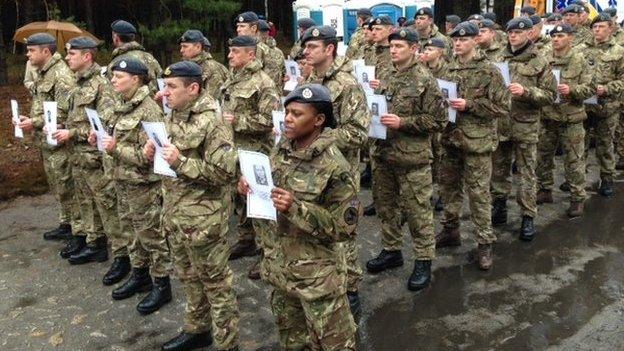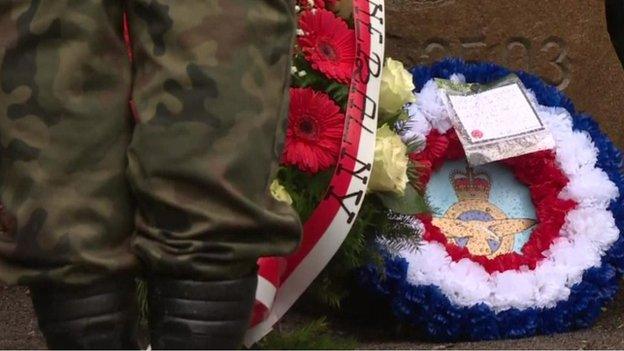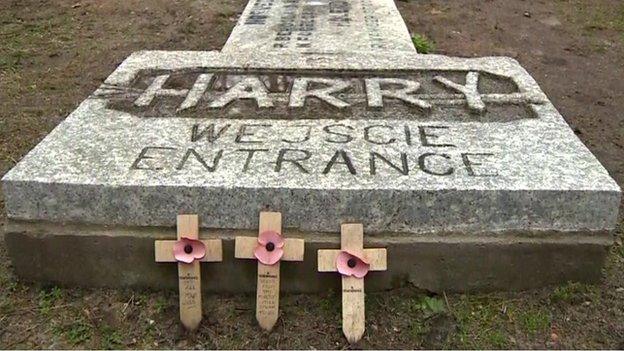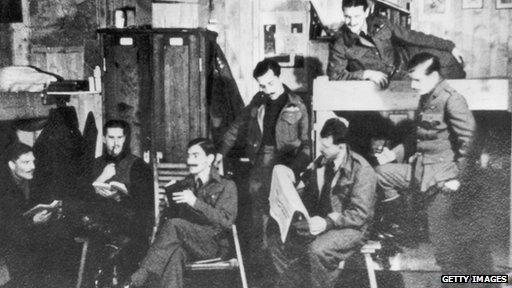'The Great Escape' commemorated in Poland
- Published

Some 50 serving RAF personnel each held a photo of one of the men killed
Hundreds of people have gathered in Zagan, Poland, to remember the allied prisoners of war who died in The Great Escape of World War Two.
Seventy years ago, 76 servicemen fled from the German Stalag Luft III camp through a 336ft (102m) long tunnel.
Only three reached safety. Of the 73 recaptured, 50 were shot.
Veterans joined family members from around the world to lay wreaths at the exit of the "Harry" tunnel in the first formal act of remembrance for the dead.
Some 50 serving RAF personnel each held a photo of one of the 50 dead at the ceremony in the forest above where the tunnel had been dug by prisoners of war.
A small number of surviving former prisoners of the camp were among those who paid their respects.

Serving personnel joined veterans to lay wreaths

The tunnels were dug to a depth of 28ft (8.5m)
BBC correspondent Robert Hall said the ceremony was all about those who had paid the ultimate sacrifice in 1944 for that act of defiance.
He said that, while the number of eyewitnesses was dwindling, the fascination with this tale of endeavour and sacrifice still endured.
The RAF's Air Vice Marshal Stuart Atha told those gathered that The Great Escape was "an extraordinary chapter" in the history of the allied air forces "written by men with great courage and character".
Those who escaped were "an exceptional band of airmen whose bravery, ingenuity and resilient spirit set an example for all time", he added.
"When first captured, they did not accept that for them the war was over.
"Far from it, they were not prisoners of war - they were prisoners at war.
"And through their activities, they opened another front that distracted and diluted enemy forces and demonstrated that no fence, no Stalag Luft, could contain allied airmen."
British ambassador to Poland Robin Barnett and former prisoner of war Charles Clarke were among others who spoke.
Daring bid
On Tuesday, 50 RAF service personnel will begin a four-day, 105-mile (170km) march from Zagan to a cemetery at Poznan where the shot men are buried.
Air Commodore Clarke was a prisoner at the German camp immortalised in The Great Escape
They will lay wreaths at the graves of the prisoners in a service on Friday.
Stalag Luft III, which was 100 miles south-east of Berlin on the Polish border, held about 10,000 prisoners at the height of its occupation.
Members of the RAF and other allied forces were among prisoners at the camp.
Because of border changes, the location of the camp is now in Poland.
The daring bid for freedom was immortalised in the classic 1963 film The Great Escape, starring Steve McQueen, James Garner and Richard Attenborough.
An escape committee was formed at Stalag Luft III in spring 1943 and the escape plan hatched under the leadership of Squadron Leader Roger Bushell.
Three tunnels, codenamed Tom, Dick and Harry, were started in April 1943.
The tunnels were dug to a depth of 28ft (8.5m) and shored up with wooden boards from the prisoners' beds.
On the night of 24 March 1944, about 200 prisoners prepared to escape through Harry, a tunnel measuring over 300ft long, beneath Hut 104.
Only 76 were able to make their break for freedom using the tunnel.
Norwegian pilots Per Bergsland and Jens Muller, and Dutch pilot Bram van der Stok - who all died in the 1990s - made it to safety.
Of the 73 who were recaptured, 50 were subsequently shot by the Gestapo on Adolf Hitler's orders.
Hitler's 'rage'
British ex-serviceman Andrew Wiseman, who was in Zagan for the commemoration, arrived as a prisoner at Stalag Luft III shortly after The Great Escape.
"When I arrived at the camp, the camp was in a state of shock, disbelief," he told BBC Radio 4's Today programme.
"Until the Great Escape, and the murder of the 50, the RAF prisoners of war were treated reasonably well by the Germans.
"But after The Great Escape, relations between us and the Germans changed.
"The camp could not believe what the Germans had done to the 50 and there was shock, horror almost, and a great deal of sadness."
German disbelief
According to the Daily Telegraph, Dick Churchill, 94, is the last British survivor among the 76 escapees.

RAF airmen were kept prisoner at Stalag Luft III
He and fellow escapee, Australian Paul Royle, are the only survivors, it says.
Mr Churchill, who says he was captured while hiding in a barn after heading towards Czechoslovakia, told the paper he was lucky not to have been shot.
"I think it was my name - I'm pretty certain.
"I'm not related to Churchill, to my knowledge. But they thought I might be."
- Published16 October 2013
- Published4 June 2011
- Published19 January 2011